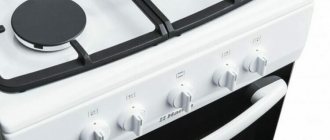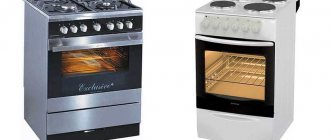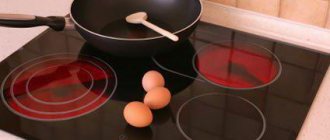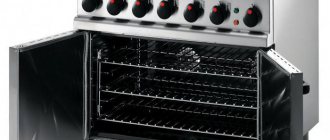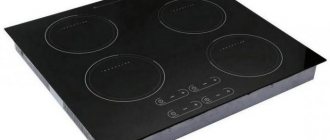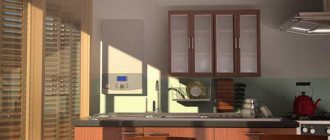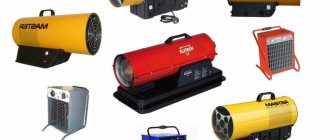Most of the operations discussed below are not recommended to be done on your own - simply prohibited. Compiles the work of gas service employees. You will be surprised: why provide information. Practice shows: there are people who want to make a spaceship with their own hands. To prevent anything from happening in the process, here is a thematic overview of the heavenly summers... that is, gas equipment. Do not consider it as a guide or instruction. A warning to those who decide to secretly find out why a gas stove smokes. Without calling the experts, he began to fight the problem. To prevent more troubles, read a couple of pages carefully. Soot from a gas stove... Let's try to figure it out...
Another master is like a hurricane. One took 600 rubles, simultaneously breaking the float of the toilet barrel in order to finalize the developer’s deficiencies. The second hooves pricked the tiles that were waiting to be grouted. (I was warned when I broke it - I blinked my eyes, asking: what is that crack?) Choose a master carefully.
Tales about gas and gas stoves
The stove is smoking, if something happens at the dacha, you have to call the service technicians. Specialists refuse to work on weekends and holidays; they need to cook urgently now; here is a brief overview of the problem of smoking stoves.
The gas stove smokes - there are two reasons:
- The gas contains excess sulfur impurities, which produces thick black smoke.
- The gas pressure is abnormal. Exceeds the nominal value of the plate and injectors. Residential main line pressure is low. By default, household appliances are designed to work in these conditions. More often, the problem terrorizes summer residents who connect their home gas stove to a purchased cylinder.
Safety precautions
@stroy-podskazka.ru
Operation of any gas stove must be carried out in accordance with the instructions for the specific model and general safety rules:
- Once you have finished cooking, as well as planning cleaning and repairs, you must completely shut off the gas supply.
- The tile hoses must not be kinked, compressed or stretched.
- Temporary connection of wires is prohibited.
- The kitchen area should be well ventilated; cluttering of furniture and placement of flammable materials and liquids is unacceptable.
At the slightest suspicion of a malfunction of the device, you should stop using it. Independent repair attempts are permissible only in extreme cases; it is better to entrust this process to professionals.
Poor quality gas cylinder
Bottled gas contains sulfur impurities - the summer resident is free to complain to Rospotrebnadzor and other supervisory and monitoring organizations. He will provide a fuel receipt, a gas cylinder for analysis, and write a statement. Before the enterprise, make an attempt to complete the matter peacefully; the conditions of Russian reality increase the chance of confrontations.
The gas stove smokes - the contents of the cylinder are of poor quality. Let's work out the algorithm:
- You will have to resign yourself to swallowing the fact or try to relocate the cylinder, stove, where the soot is powerless to cause damage to property.
- Later we will contact the organization that filled the cylinder to explain the issue of excess sulfur.
- Seeing the seller’s lack of understanding of the situation, we complain, trying to restore justice.
If you have friends who have purchased gas from the organization, inquire in a friendly manner whether the gas stove smokes. One head is good, two are better. It is much more pleasant to while away the time with a friendly conversation than to silently wait in line.
When raising the alarm by blaming the gas supplier, read the review first. Perhaps the reason is limited to incorrect settings of gas equipment.
Main causes of soot
The gas stove operates normally if the flame in the burner is a natural blue color, without any red and/or yellow tint. When multi-colored tongues appear in the flame, the gas is supplied unevenly, then such work cannot be called correct. A reddish tint to the flame indicates that the fuel is not completely burned or there is not enough air to burn the gas.
The presence of red flames often precedes the appearance of soot.
The cause of this unpleasant phenomenon is considered to be:
- low gas quality;
- high/low blood pressure.
When the gas mixture contains too much mercaptan sulfur, thick, black smoke appears, the particles of which settle on the dishes and walls of the room.
Incorrect operation of the burners, the presence of soot during the combustion process may indicate low gas quality, low or high pressure in the system
A similar situation occurs when the stove is connected to a low-quality cylinder with a low gas content. In some cases, soot appears when there is a malfunction of the burner itself.
Let's look at the main reasons in more detail.
Reason #1 - low fuel quality
When understanding why soot appears from a working gas stove, it is important to know that the cylinders are filled with a gas mixture. When the composition has a high sulfur content, soot appears.
If you are absolutely sure that the cause of the soot was poor-quality fuel, you can file a complaint with Rospotrebnadzor and other similar organizations.
Along with the application you will need to provide:
- a receipt issued when refilling the cylinder;
- the tank itself (cylinder) with low-quality fuel for examination.
Often such incidents are resolved peacefully in favor of gas consumers. You don’t know what to do when a gas stove powered by a cylinder smokes and what measures can be taken immediately?
Then remember a simple algorithm:
- try moving the cylinder or gas stove to another place;
- if you have friends who use the services of the same organization that refills cylinders, check whether their gas stove smokes;
- contact your fuel supplier with a request to explain the increased sulfur content in the gas mixture;
- If there is no contact with the organization that refills the cylinders, write a complaint with a request to restore justice and compensate for the cost of property damaged by soot.
When starting a dispute with your fuel supplier, make sure that the problem is gas quality. We also recommend that you familiarize yourself with the requirements for cylinders when refilling and filling standards.
The actions of unscrupulous suppliers do not pose a threat to the health of bottled gas users, but create a lot of inconvenience during operation
In addition to problems with gas supplies, the cause of soot is often the need to adjust equipment and eliminate malfunctions.
Reason #2 - incorrect stove settings
When understanding why a household gas stove connected to a propane cylinder smokes, it is important to assess the pressure level in the system. It depends not only on the quality of the cylinder, but also on the operating features of the burner. To deal with the problem, it is important to know the device of the latter.
The burner consists of the following elements:
- Divider – designed to evenly distribute fuel along the entire perimeter of the burner. In appearance, the divider resembles a sleeve, which is cut along the contour.
- The divider cover provides the required diameter; it looks like a round-shaped cover made of stainless steel, located on the top of the divider.
- An electric spark plug is an element of modern models of gas stoves. The spark is a signal to start work; it ignites the gas. The candle is located on the side of the divider, and a temperature sensor is placed nearby, which ensures safe operation of the stove. If the fire goes out, a command is transmitted to a special electromechanical device,
- The jet is located under the divider and looks like a small bolt with a through axial hole. The injector is responsible for uniform fuel supply and regulates pressure.
The appearance of soot, incorrect operation of the gas stove - all this is often associated with the installed nozzle, or rather, with a hole in it that is too large.
When disassembling the burner, pay attention to the nozzle. The hole in it should not exceed 1 mm, otherwise soot will form when the gas burns
Uneven fuel supply may be due to blockages. To clean the nozzle, you need to carefully insert a thin wire into the hole and twist it between your fingers. It is not recommended to press or pick the jet. This can lead to an enlargement of the hole and the appearance of soot.
If there is dirt, be sure to clean other parts as well, as soot may appear as a result of combustion of deposits that have accumulated on the burner surfaces. Scrub all the elements well with an old toothbrush dipped in detergent. Then rinse the parts under running water and dry well. Only after this proceed to assembling the gas stove.
Reason #3 - insufficient air volume
An insufficient amount of air supplied to the burner will lead to the appearance of soot even if all other elements are in good working order. To adjust the air discs, unscrew the locking screw and act very carefully.
The adjustment of the air discs is carried out very carefully. At the end of the work, the flame should burn evenly; there should be no extraneous sounds during operation of the burner.
After adjusting the operation of the air discs, you must immediately check the quality of the gas stove.
When the burner is turned on, the gas should burn without any extraneous sounds or buzzing. The flames should not be more than 2.5 cm in height. If the adjustment does not help, you should return the air discs to their original position.
The gas stove is not set up correctly
Required by a special service. The gas stove burner smokes - the inlet pressure is too high. Bottled gas in a highly compressed state cannot be compared with the blue fuel supply line for residential buildings.
Internal structure of the burner
Avoiding fainting, considering the idea of getting inside the burner so as not to spoil anything inside, study the following information.
Excluding old stoves from Soviet times, considering modern kitchen equipment - electric models are supplied with replaceable jets in two sets. The burners are composed of the following main parts:
- The divider is a part of the form of a flange sleeve, cut with tower teeth along the perimeter, through which the gas is distributed evenly in a circle.
- Divider cover. The divider is covered on top with a round plate. Made from stainless steel, many options are available today. Doesn't play a role.
Sometimes the design is complemented by an electric spark plug protruding from the side of the divider. The spark acts like the ignition of an ordinary car. Electricity ignites blue fuel. There is a temperature sensor near the spark plug. Externally similar, a person seeing the design for the first time will confuse the two elements. The sensor helps the stove understand whether the gas is burning. Goes out - a special electromagnetic valve shuts off the fuel supply, excluding a fire.
If you take out the divider and the cover, you will find the jet. A small bolt with a through axial hole. Bypassing the nozzle head, the gas enters the divider and then burns. The stove is smoking - the hole is too large. You will notice a small hole with a diameter of a millimeter on the nozzle. The part is yellowish in color, made of brass, bronze of a similar alloy. The quality of the jet and the correct installation ensure the safety of those living next to a smoking gas stove; we carefully consider the pitfalls step by step.
Slab prevention
@plithome.ru
To prevent malfunctions in the operation of gas equipment, it is important to initially adjust the fuel supply process, and then follow simple rules:
- Regularly clean the device from dirt and rinse the nozzles.
- Monitor the quality of the gas mixture, find reliable suppliers.
- Avoid mechanical damage to burners, hoses, and wires.
Most importantly, it is important to provide gas workers with the opportunity to carry out a scheduled annual inspection of gas equipment; a timely visit from professionals will help identify and eliminate problems.
Modification of the smoking plate jet
A modern gas stove is equipped with two sets of jets, two sets are attached. The manufacturer is aware of the problem: the equipment smokes when switching from main gas to bottled gas. The kit is completed with a socket wrench and two types of jets. Provide your garden equipment with smaller holes (0.8 mm).
Please note: the jet will enter crookedly, it will begin to bleed gas to the side, and household members will have a chance to fly into the air. Only a person with straight arms and sharp eyesight is able to perform an operation, avoiding harm with a probability so high that he does not have to worry about the consequences.
There is no second set of jets, there is no way to buy them - you will have to modify the improvised ones. We remind you that this is not a guide, but safety advice for those who refuse to invite gas workers. You will need a soldering iron, solder, a set of sewing needles, and a couple of hours of time.
First of all, the brass is deprived of its oxide film, the solder will sit securely on the metal. Stop rushing with the rosin: take some alcohol and carefully wipe the nozzle with clean hands. After the hole, the cap is rosinized, the oxide film is peeled off, a drop of solder is applied, and the tin will enter the hole.
The drop is sanded down flush with the cap. It's time for the needles. We take a small one and pierce a hole, then a second, larger one. We bring the diameter of the hole to 0.5 mm (you can measure the diameter of the needle with a caliper), try to screw the jet back. The flame is blue, devoid of a single yellow tongue, confident, not smoky. The result corresponds to the description of a normal flame - take the second jet.
The first time is rarely successful. We take out the jet and use a set of needles to widen the hole. Every 0.1 mm we try the result. Please note: the hole is strictly parallel to the axis of the nozzle so that it stands vertically in the gas stove. Failure to comply will result in the release of blue fuel and an explosion will occur. At first, the gas stove, equipped with new jets, was tyrannized by continuous supervision.
The stove is powered by a gas main
To understand the cause of soot, you need to know how a gas stove works. The design of any modern stove, in addition to the oven, includes such an important element as a burner, thanks to which gas is used safely for cooking. It consists of several parts.
- The first thing you notice is the divider. It is presented as a gear flange bushing. The space between the teeth distributes the gas in a circle, creating an even flame.
- The design is complemented by a divider cover located in the upper part of the burner. Most often they are made of durable stainless steel, but the material can be any.
Having disassembled the burner to the base, you can see a small bolt with a through hole in the middle. This part is called a jet. Its diameter does not exceed one millimeter, and it is through it that the gas enters the divider. Most often, the part is made of brass or a material with similar properties. If the bolt hole is too large, the burner will start to smoke.
Modern manufacturers take this into account and supply, along with the main set, a set of replaceable jets with a hole of about 0.8 mm.
Replacing the jet if you have a replacement kit is quite easy - any home craftsman can do it.
What to do when the stove smokes
If your gas stove smokes, you first need to rinse it thoroughly:
- Remove the flame breakers if there are pieces of food and fat stuck to their cells; first, soak them in a cleaning solution, then carefully clean them from the stuck dirt.
- If the nozzle hole is clogged, you can also soak it and then clean it with a thin metal wire or needle. Then dry well.
If after washing the burners do not stop smoking, then you should pay attention to the diameter of the nozzle outlet. Modern models are equipped with two sets of nozzles (with a diameter of 6-7 mm for liquefied gas, 8 mm for central gas supply)
If you decide to change the nozzles yourself, you should remember that you need to tighten them strictly perpendicular to the surface of the tile. Otherwise, the gas will be supplied unevenly to the burner. This can lead to unpleasant consequences.
If parts of the burner are deformed during operation, they must be replaced with new ones; you should not even begin to correct them.
Oven thermostat does not regulate flame
Housewives who do not very well understand how the oven thermostat works often complain about this effect. If you have a stove with a thermostat, then when you change the position of the regulator, the flame may not change immediately. The thermostat works like this: first, while the oven is cold, the gas is supplied at full power, no matter how the engine is installed. As it heats up to the desired temperature (this is what is set on the regulator), the valve gradually closes and the flame decreases.
But two other malfunctions may be associated with the thermostat. Firstly
, after heating the oven, the flame may go out.
Secondly
, the flame may burn too hot, despite the fact that the oven has already warmed up. Both of these problems are caused by improper adjustment of the low fuel screw on the oven burner (Figure 3.A).
Figure 3. The faucet handles and the front panel under these faucets have been removed.
This screw needs to be turned out a little. Light the oven and close it. Set the regulator to 140 degrees. Wait 10 minutes. Now, by adjusting the screw, you need to ensure that the flame is small (the tongues are about 4 mm), but burns steadily and does not go out. Usually this is easy. But sometimes, even with the low flow screw fully tightened, the flame is too large. The fact is that there is a small hole in the screw, which prevents the gas supply from being completely blocked even when the screw is screwed in completely. Why this hole is needed, I still haven’t figured out. But the fact remains a fact. If the flame cannot be reduced to the required level, then the screw must be unscrewed completely and replaced with a screw with a smaller hole, or the hole must be sealed with Poxypol (it is absolutely useless). Then screw in the screw again and adjust the flame.
All of the above applies to an oven with a thermostat. The burner with tap is adjusted in the same way as the table burners. It is very easy to distinguish a thermostat from a faucet. Temperature values are written on the thermostat scale. The faucet scale has just numbers.
Common causes of smoking burners
When everything is working stably, the flame of the burner should be blue, evenly distributed over the working area. A reddish or yellow color indicates a lack of oxygen, the presence of additives in the mixture, or incomplete combustion. It is this coloring of the fire that leads to smoking.
There are several common breakdowns that cause soot to appear on pots, pans, cauldrons or hoods under high flame:
- Nozzle clogged. In this case, the mixture coming from the hole that cuts the flame does not pass completely; its path is blocked by debris, dirt, adhering fat, and carbon deposits. The fix is simple - remove the top cover, and clean the nozzle, sometimes with particularly severe congestion, soak it in water. Then everything is installed back.
- The hole cutting through the fire was deformed. Repair is not possible here; replacement is required. Deformation occurs for various reasons, often due to prolonged operation without maintenance.
- Low quality fuel, too many sulfur elements. With main gas supply, such a nuisance is extremely rare. Often smokes a gas cylinder used at the dacha or in a private country house. We need to change the supplier, replace it urgently.
- High pressure in the tank. The fuel simply does not have time to burn, so the burner smokes. You need to adjust the pressure, and everything will return to normal.
As you can see, not all moments when a gas stove smokes from a gas cylinder or line are directly related to the operation of the equipment. That is why it is better to refuse to attempt to repair the product on your own, since unprofessional intervention can harm stable functioning equipment.
If the oven burner does not light on the stove
If after pressing the ignition button the flame burns, but after a minute of warming up and after releasing the button it goes out, the reason lies in a malfunction of the security system. First, it makes sense to make sure that the flame sensor is installed correctly. It should be on fire and warm up well. If the fire goes out and the installation is correct, the safety device itself has probably failed and needs to be replaced.
There are two types of devices in gas stoves:
- The first one is a sensor - a copper flask with liquid or gas. As the temperature increases, the liquid/gas expands or evaporates. This leads to increased pressure, which is transmitted through a thin copper tube to the valve. This keeps the latter open. Here the breakdowns are caused by the loss of the seal of the flask, which is why the burner does not want to ignite. The only way out is to replace the flask;
- the second is a thermocouple. When heated, such a sensor emits electricity. It is supplied through wires to an electromagnet that holds the valve open. Here the breakdowns consist of damage to the wires due to which the thermocouple is not able to contact the electromagnet. Plus, just like on the cooking table, as I mentioned above, the thermocouple and electromagnet itself can burn out.
If the stove is powered by bottled gas
As a rule, there are two main reasons for the formation of soot in a gas stove. The first is the sulfur impurities that the gas cylinder contains. As you know, when this substance burns, it produces acrid black smoke. This is what owners see when using low-quality gas.
If you have replaced the cylinder, but the stove continues to cause inconvenience, pay attention to the pressure level. It happens that it exceeds the indicators that were included in the slab during development
This is due to low gas pressure in the pipelines of residential buildings, which household appliances are designed to work with. Attempts to connect a simple home stove to a gas cylinder can cause internal problems, which result in the appearance of soot.
Gas impurities
So, if you find yourself in a situation where soot appears due to the impurities contained in the cylinder, there is no need to panic. It is necessary to carry out the following manipulations.
- Move the household appliance to a more suitable room, where the property will not suffer as much damage. The smartest solution would be to temporarily stop using the stove, but in reality this may cause problems. Most people may simply not have an alternative way to prepare food.
- Having resolved the issue with the location, you need to contact the supplier company for an explanation. The seller must exchange the defective product or compensate for losses.
- In case of refusal by the supplier, you can send a complaint to the control authorities.
Gas pressure problems
You shouldn’t get excited and throw accusations; the problem can arise for other reasons. Carefully inspect your device for internal faults: it may not be designed to work with cylinders. This information can be found in the instructions for the equipment. The main part of the stoves is designed to be connected to the mains of a residential building, so excessively high gas pressure can cause the burner to smoke.
